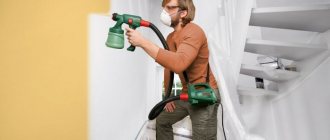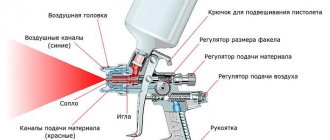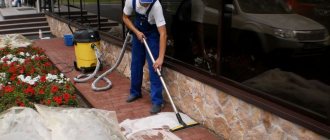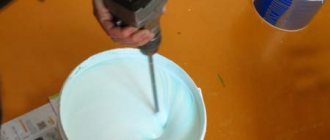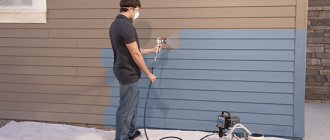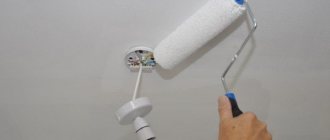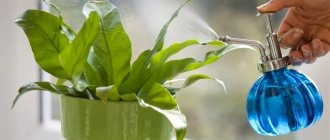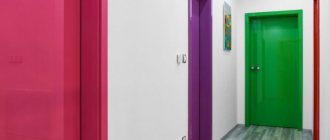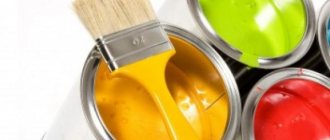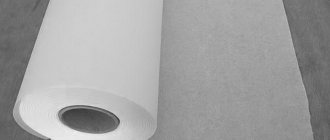The application of paint and varnish material to a surface has certain features, the observance of which determines the overall quality of the applied coating. When working with a pneumatic spray gun, you should adhere to the established sequence of actions to ensure the best result, without smudges, streaks or peeling of the material. If you have started paint spraying procedures, but do not yet have experience in carrying them out, this publication will help you understand the technology of the process and will bring your work closer to a professional level. We hope that the presented theoretical basis will become a good basis for your further development in the field of painting.
Types of spray guns and their differences
Before we talk about how to use a spray gun, let's figure out what they can be and what they are used for. First of all, they are intended for applying paint and varnish material, but the applicability of paintwork materials by type and the quality of work will differ.
Pneumatic spray gun
Painting with a pneumatic spray gun Source 1pofasadu.ru
The most popular type of spray gun in a professional environment. It works in combination with a compressor that delivers the required pressure. It features high-quality results. The operating principle is based on feeding paintwork materials into a nozzle through which a powerful air flow passes. Upon meeting, it breaks the paint structure into fine dispersed dust and sprays through the so-called torch.
Pneumatic sprayers can be with an upper or lower location of the working container. The remaining design features on most models are almost identical.
Healthy! The advantage of such spray guns is the minimal consumption of paint, which is applied in a thin and even layer.
Ceiling painting technology
Painting the ceiling with a spray gun is done according to a slightly different scheme than working on the surface of the walls. This achieves better results compared to a roller or brushes.
Advice! It is recommended to paint the ceiling with water-based paint. This is due not only to good adhesion performance, but also to basic safety requirements. The likelihood of dye getting on the skin or in the eyes when finishing the ceiling is quite high, and water-based paint causes minimal negative consequences when in contact with sensitive body tissues.
How to use a spray gun
Surface painting using an electric or pneumatic spray gun is carried out in the following sequence:
- Preparing the base. At this stage, the surface is cleaned of the old layer of paint and rust, plastered, primed, degreased, and dried. Other preparatory work is carried out, the order and duration of which are assessed individually.
- Preparation of paint solution. The viscosity of the composition is selected according to the recommendations of the tool manufacturer. The viscosity must correspond to the nozzle diameter.
Healthy! Most kits have a special measuring funnel for this purpose. With its help, you can easily and quickly determine the fluidity of the paint and varnish material. It’s quite simple to use: you need to pour the specified amount of diluted paint and time how long it takes for it to flow out of it.
- Inspection and assembly of the spray gun and test painting with assessment of the quality of the resulting surface.
- The main stage of applying paint.
- Cleaning the instrument. A crucial point, ignoring which will lead to the unusability of the spray gun.
Continuous dyeing principle
In continuous painting, the spray gun is turned on at the start of spraying and kept on until the part is completely covered with paint. In certain cases, this principle greatly increases work productivity, allowing the maximum number of parts to be painted per unit of time.
For example, wheel covers can be mounted on a special rotating mandrel and each wheel cover can be painted in one continuous pass.
Since the cap rotates, all we have to do is hold the trigger, and when the main part of the cap is painted (starting from the center), with a small movement, move the gun down 5 centimeters to complete painting the entire width of the cap.
The picture below shows how, through continuous painting, you can paint a voluminous and flat surface. In both cases, the spray gun remains on until the end of the painting operation.
General view and design of the tool
Before using a spray gun, you should understand its design. As mentioned earlier, the design of electric and pneumatic devices is almost the same. Therefore, let’s consider the situation on one of the most popular versions designed to work with a compressor.
General view and design of the instrument Source instrumentoria.ru
“Splash” technique
Sometimes, when painting very inconvenient and hard-to-reach places, for example some inaccessible areas of the engine compartment, the “spray” technique can come to the rescue. We remove the air supply to the sprayer and reduce the torch to its minimum size. In this case, the paint will spray from the nozzle in a thin stream and it can be “poured” to places where it is impossible to reach in any other way. Of course, there can be no talk about the quality of the painting, but when this technique is used, it is not really needed.
Manual
Regularly check the tightness of bolted connections before starting work. This primarily concerns the adjusting screws and the air intake nut. Repairs and maintenance are carried out only with the device de-energized. Violation of safety precautions can lead to serious consequences.
The procedure for working with a spray gun begins with preparing the device for the task. To do this you will need:
- Set the nozzle to the desired size.
- Blow out and make sure the air supply hose is intact. Use it to connect a compressor with a spray gun.
- Turn on the device and select the appropriate shade, adjust the air supply, paint and torch width. This is done not on the surface being processed, but on a template. It is recommended to start painting only after all the mentioned settings have been completed.
How to work with a spray gun correctly Source evrotek.spb.ru
To prevent overspray, keep the distance between the torch and the surface to be treated in the range of 15-25 cm. You need to spray the composition evenly, moving the spray gun perpendicular to the surface, as shown in the image.
The answer to the question of how to use a spray gun correctly will remain incomplete if we do not mention the mandatory cleaning of the tool after completion of work. Cleaning is carried out with a solvent, white spirit, solvent or other composition with similar characteristics. To do this, unscrew all elements that come into contact with the coloring composition and rinse them thoroughly. The easiest way to clean a spray gun is to bathe it in a solution poured into a small container (on average, it takes about 300-400 g of white spirit to wash a tool).
Complete disassembly and cleaning of the spray gun Source kraskistroi.ru
Healthy! Before taking our advice, carefully read the instruction manual for your device. Some manufacturers categorically do not recommend putting the gun in solvent.
Hardened areas are rubbed off manually. It is not recommended to use hard objects for these purposes. To clean the nozzle nozzles, you can use needles whose cross-section corresponds to the diameter of the holes.
Important! Rinse the spray gun immediately after completing paint work (before the paint begins to harden) and never leave it soaked in solvent or its analogues.
Painting a panel part
We have sorted out the basic points, now we can consider the features of painting a specific part. Let it be a rectangular panel element, without sudden changes in surface topography. For example, a removed hood.
If possible, it is best to place the part vertically, with a slight tilt away from you. The height of the part should be such that you don’t have to work most of the time while standing on tiptoes, but also not bend over backwards. Before painting, take a comfortable position in which you can, practically without leaving your spot, reach all areas of the element to be painted.
Check to see if your arm span is sufficient when moving from the far left to the far right position to cover the width of the part in one pass. It is better to do all fittings with a spray gun in hand.
As we remember, painting is carried out by applying horizontally oriented stripes to the surface from a distance of 15-20 cm, formed when the spray gun moves from left to right and back.
Preparing the paint
A small electric spray gun for the home Source i1.wp.com
A feature of spraying paint with a spray gun is the strict requirements for the composition used. The consistency must have the viscosity declared by the tool manufacturer. Too thick a composition will lead to uneven distribution, increased drying time and waste of material. When applied to inclined or vertical surfaces, this will negatively affect the quality of the paint. Microcracks and roughness will be unevenly covered.
Paint diluted very thinly will not be able to completely cover the surface and will require a second coat. The result will be an increase in the volume and time spent on work.
To achieve the specified thickness of the paint and varnish material, a liquid recommended by the paint and varnish manufacturer is added to it. It can be a solvent, white spirit, gasoline, solvent, water.
Important! The type of paint thinner for the spray gun is selected in accordance with the paintwork material used.
Surface preparation
Before figuring out how to paint correctly with a spray gun, you should pay attention to an earlier stage of work. Surface preparation before painting is of fundamental importance in the entire process, on which the reliability of the adhesion of the material and the final appearance depend. Despite its importance, the preparation process is quite simple and requires only a little attention.
A good surface for painting should be washed (not greasy), sanded and dry. If there is dirt or grease on the element being processed, the density of adhesion of the paintwork material to its surface will be minimal, which will lead to easy abrasion of the material and the formation of bubbles. Sanding with fine-grained sandpaper forms tiny grooves on the surface, and at the same time levels it to an almost ideal (for the human eye) state. Light roughness allows the paint to penetrate into the “pores” of the element being processed, which significantly increases the strength of the gluing. Excess moisture, such as dirt and grease, does not contribute to the overall picture and causes the applied material to peel off.
We strongly recommend that you take the surface preparation stage seriously, as 80% of success depends on it.
Features of working with a spray gun
Standard set for a compressor Source kontrast-kraski.ru
Using a spray gun, you can spray various types of paints and varnishes: oil, latex, acrylic, alkyd and other types of paints. The only condition that must be met is the fluidity of the composition. Its value is selected individually, depending on the characteristics of the instrument. You can find the exact value for each model in the instruction manual.
The spray gun trigger is pressed evenly Source vmirekraski.ru
How the principle of collecting paint in a spray gun is constructed Source idoallsam.ru
In addition, when working with a spray gun, you should pay attention to a number of other equally important aspects:
- When carrying out interior work, you need to prepare the room for painting: close or remove interior items that cannot be painted. When covering, secure the material with masking tape.
- The composition should be sprayed so that spilled drops and particles flying past the surface to be painted do not fall on those that remain uncovered.
- When working outside, choose a position based on the wind and its possible gusts.
- It is recommended to use personal protective equipment when working with a spray gun: gloves, goggles, respirator.
- When using stagnant paint, strain it through cheesecloth. This will clear the composition of lumps that can cause clogging of the instrument.
- Do not apply copious amounts of paint at once. This will cause the formation of streaks and drops.
- Each subsequent row slightly overlaps the previous one, which minimizes the likelihood of unpainted areas.
- The second and subsequent layers are applied after the previous one has completely dried (the duration depends on the temperature conditions and the type of paint used).
Advice! If you do not have experience with a spray gun, start painting from the “back”, “less noticeable, significant” area. Don't touch the front one yet. During the course of the work, you will gain certain skills and be able to create a higher-quality coating than at the very beginning of painting (on the “less significant side”).
How a spray gun works Source avtograph-oem.ru
“The finishing touch” technique. Painting wings, doors
More difficult is painting parts with clearly defined outer and inner corners (for example, wings). The so-called “finishing touch” technique will help us successfully cope with this task. It is also used when it is necessary to paint a part on both sides.
Its essence lies in the fact that first the internal parts of the part, the ends and external corners are painted, and only then the front part. This technique allows you to obtain a high-quality coating, avoiding overspray on the front part of the part, and slightly reduce paint consumption.
Let's take the front fender for example.
- First we go to the ends: we paint the upper area (places of bolted connections).
- Then we move to the front end (the place for the turn signal).
- We go down, painting the wheel arch and all the lower ends.
- We move on to the end that looks at the front door. That's it with the ends.
- Now we paint the entire front surface of the wing. Voila, the wing is painted!
Same thing with the door. To prevent dust from spoiling the front part, we paint the inside and ends first, and the front part last.
What should the torch size be?
To achieve maximum efficiency when painting, experts recommend applying the paint layer using a torch of the maximum size. The larger the width of the torch, the more uniform the layer of paint applied to the surface is. To achieve the maximum width of the torch, it is necessary to unscrew the adjusting screw to the maximum in the “+” direction.
If you need to paint a small part or part of a car body, then you should reduce the size of the torch. It is important to remember that the position of the adjusting screw at “—” ensures the application of a paint layer in the shape of a circle. When the regulator is turned to “+”, an oval shape of application of the paint layer with an increased width is obtained.
Equipment selection
Let's start with what is best to paint.
Spray gun
There are three types of sprayers on sale:
- HP (with white or silver markings).
- LPHV (with green marks on screws).
- LPLV (marked in blue).
Their price varies from a minimum of 300 rubles for the first category of devices to an impressive 8-10 thousand for LPLV spray guns.
Let us clarify: there are also compact electric sprayers on the market, the compressor of which is combined with a spray gun. To operate such a device, only power is required. For household painting of relatively small surfaces, electric sprayers are the ideal choice.
What is the difference between different types of spray guns? Why do they differ so much in cost?
HP (sometimes labeled as CONV) are High Pressure devices used in their current form for almost a century. The operating pressure reaches 5-6 atmospheres with a relatively large air flow. The downside of cheapness is a huge waste of dye: its transfer is only 30-50 percent; most of the aerosol ends up uselessly on the floor.
LPHV – low pressure sprayers that use a large volume of air (Low Pressure, High Volume). For their operation, an excess pressure of about one atmosphere is required; paint transfer reaches 70%. An additional bonus is much less air pollution from aerosols of organic solvents, most of which are very toxic.
LPLV (Low Pressure, Low Volume) operate at low pressure with minimal air flow. As you might guess, they are very unpretentious when choosing a compressor for painting; More importantly, the paint transfer of these devices is close to 90 percent of the volume used.
Three generations of sprayers in one photo.
Compressor
What kind of compressor can be used for painting? What criteria should you use to choose these devices? First, let's delve into their classification.
Screw and piston
A piston compressor is a relatively simple device consisting of a motor, a crank mechanism, a cylinder with a piston and a pair of check valves. During the working stroke of the piston, compressed air is pushed into the discharge pipe; when idle, it is taken from outside.
The screw design is much more interesting. Two tightly fitting rotors, rotating, continuously displace air from the groove between them into the discharge pipe.
This scheme of work provides quite a few advantages:
- The service life between overhauls is much longer than that of any piston design.
- The outlet pressure is very stable even without the use of a receiver (air storage tank).
- The noise level is noticeably lower.
The only reason why screw compressors have very limited popularity is their high cost. If a high-quality piston device with a power of about two kilowatts can be bought for 6-8 thousand rubles, then the cheapest screw compressors made in Belarus are offered on the Russian market for 110-120 thousand.
Working chamber of a screw compressor.
Oil and oil-free
Piston compressors are divided into oil and oil-free. It’s not hard to guess what the difference is.
What does filling the crankcase with oil affect?
- For compressor life.
- On the noise level during operation.
Obviously, oil-based devices are preferable, despite the need for periodic maintenance.
Belt and direct drive
Rotation can be transmitted from an electric motor either directly, through a common axis, or through two pulleys of different diameters and a belt. The first scheme is simpler and more compact; however, the second is somewhat more preferable: it allows you to achieve greater compression in the cylinder at lower speeds and less power of the electric motor.
However: the belt will need periodic replacement. During operation, it continuously experiences deforming loads.
Belt driven compressor.
What else should you pay attention to when buying an air compressor?
- On electrical power, which determines the performance of the device. It is better to take a closer look at compressors that consume at least 2 kilowatts. Do not be afraid of excessive consumption of electricity: when the set pressure in the receiver is reached, the power will turn off.
- On the volume of the receiver. It is better that it is not less than 50 liters. The large volume of the air tank often compensates for the lack of performance, allowing the spray gun to consume more air than is pumped into the receiver.
